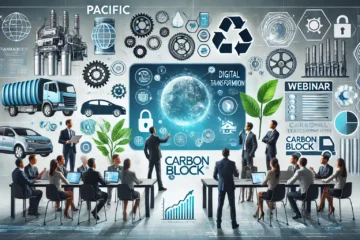Calculating Supply Chain Emissions: Key Factors & Data Sources – 8 Decarbonisation Steps
Businesses are prioritizing sustainability, focusing on ESG scores and carbon emissions. Reducing supply chain emissions is the key to a greener future.
Introduction
Businesses of all sizes, from multinational corporations to local enterprises, are intensifying their sustainability efforts. They now prioritize environmental, social, and governance (ESG) scores and Scope 1 and 2 carbon emissions. There is a notable shift towards implementing ambitious climate actions.
Many companies have turned their attention to renewable electricity, adopting rooftop solar and investing in energy-efficient systems. However, more action is needed. Decarbonizing the supply chain is crucial in mitigating climate change.
Despite increased efforts, companies often underestimate their carbon emissions, hindering net-zero targets. This urgency underscores the need for accelerated decarbonisation in supply chains and Scope 3 emissions.
Collaboration, incentivization, and product redesign are essential to achieving supply chain decarbonisation. By understanding and tracking supply chain emissions, setting ambitious yet achievable targets, and collaborating closely with suppliers, companies can make significant progress toward sustainability.
Investment in renewable energy, circular economy practices, and advocacy within industries are vital steps. Through these efforts, companies contribute to a more environmentally conscious future.

Read on to get a more detailed view of supply chain decarbonisation.
Enterprises of all types, from multinational corporations to local enterprises, are ramping up their sustainability efforts. Most focus on basic sustainable practices initially to raise awareness. They are now prioritizing their Environmental, Social, and Governance (ESG) scores, as well as Scope 1 and Scope 2 carbon emissions. They are increasingly moving towards implementing ambitious and tangible climate actions.
Businesses, NGOs, and governments are moving towards carbon neutrality. This involves purchasing renewable electricity, utilizing rooftop solar, implementing efficient lighting and heating systems, and investing in carbon credits or green initiatives to offset remaining emissions.
However, there is room for more action. Decarbonizing the supply chain is a particularly impactful step in mitigating climate change. Your role in this collective effort is crucial in making this happen. Your actions can make a significant difference.
Despite heightened efforts and awareness, companies frequently underestimate their carbon emissions, impeding their ability to achieve net-zero targets. This is concerning, given the urgency to limit global warming to 2°C.
Companies must focus on emissions from their supply chains and Scope 3 emissions and employ effective strategies to accelerate decarbonisation, expediting the shift towards a low-carbon economy.
What Is Supply Chain Decarbonisation?
Supply chain decarbonisation involves reducing or ideally eliminating the carbon footprint of a company’s suppliers. This can be achieved by:
- Decreasing the carbon footprint related to transportation and delivery.
- Assisting suppliers in transitioning to renewable energy sources.
- Redesigning products to lower the carbon footprint associated with manufacturing.
- Implementing measures to reduce the overall supply chain carbon footprint.
Understanding Supply Chain Carbon Footprint
Understanding the carbon footprint of supply chains is vital if you have to take the desired corrective actions. Every product has associated carbon emissions from sourcing, manufacturing, and transportation by suppliers.
Even if these operations are beyond your control, their carbon footprint impacts your product’s sustainability. Achieving net-zero emissions for your company won’t be truly sustainable if your product’s production still carries a significant carbon footprint.
Supply chain decarbonisation requires collaboration, incentivization, and product redesign since you have limited control over suppliers. You must engage with suppliers to align with your decarbonisation strategies and possibly redesign your product to use low-impact materials or reduce transportation distances.
If suppliers are unwilling to join the decarbonisation efforts, consider finding new suppliers that align with your sustainability goals.
The Business Case For Decarbonisation
Decarbonisation offers several benefits for companies and their suppliers:
- Cost Savings: Renewable energy sources and energy-efficient technologies like lightbulbs lead to long-term cost savings. These are essential components of decarbonisation strategies. Additionally, decarbonisation can result in tax cuts and help avoid regulatory fines.
- Improved Brand Reputation: Consumers increasingly prefer supporting sustainable companies. A small carbon footprint is a significant factor in sustainability considerations. As a result, companies are seeking suppliers with sustainable practices. Suppliers can enhance their brand reputation by reducing their carbon footprint and potentially attracting more business.
- Future-Proofing: Regulatory trends suggest that Environmental, Social, and Governance (ESG) reporting, sustainable practices, and carbon reduction will become mandatory. Developing strategies to reduce carbon footprint now allows companies and their suppliers to remain compliant with future regulations, ensuring their operations remain compliant and competitive.
Consider These Decarbonisation Steps To Improve Your Supply Chain Sustainability
Get A Closer View of Your Supply Chain-Specific Carbon Footprint
The primary step is to understand the carbon footprint of your supply chain. This includes understanding the emissions of sourcing, manufacturing, and transporting products and materials. This information will help you identify hotspots and areas you can significantly impact.
Set Ambitious Yet Realistic Targets
Once you understand your supply chain emissions, the next step is to establish ambitious yet attainable decarbonisation goals. These targets should be based on science-based methodologies and aligned with your overarching business strategy.
They should serve as catalysts for driving transformative change across supplier operations while unlocking innovative products and services.
By setting ambitious yet achievable decarbonisation targets, your company can actively contribute to easing climate change while staying aligned with its broader strategic objectives.
Collaborate With Your Partners
Collaboration is the cornerstone of supply chain decarbonisation. Engage closely with your suppliers to ensure their transition towards renewable energy sources, decrease reliance on fossil fuels, and enhance transportation efficiency.
Incentives and financial support may be necessary to promote these changes effectively. By working closely with suppliers, your company can drive meaningful progress toward a greener supply chain, achieve its sustainability goals, and promote a culture of environmental responsibility.
Track And Report Emissions Clearly
It is important to monitor and report emissions from your supply chain consistently. This allows you to track the outcome of your efforts and decarbonisation targets and pinpoint areas for improvement.
By regularly assessing emissions data, your company can make informed decisions, implement necessary adjustments, and ensure alignment with decarbonisation goals.
Transparent reporting enhances accountability and demonstrates your commitment to sustainability to stakeholders. It can boost your trust and credibility.
Become The Cheerleader For Climate Change
As a leader in decarbonisation efforts, supporting sustainability within your industry and sector is important. Collaborate with partners to align sustainable procurement practices and champion supply chain sustainability initiatives.
By leveraging collective influence, you can drive industry-wide change and promote a culture of environmental responsibility.
Engaging in advocacy benefits your company and contributes to a more sustainable future for the entire sector, furthering innovation and resilience in supply chain operations.
Invest In Renewable Energy
Implementing Virtual Power Purchase Agreements (VPPAs) with suppliers can be a powerful strategy for driving renewable energy adoption.
These agreements involve joint commitments between your company and suppliers to purchase renewable energy and support the development of new renewable energy projects.
By partnering with suppliers in VPPAs, you can collectively contribute to the growth of renewable energy sources while reducing carbon footprints across the supply chain. This demonstrates a strong commitment to sustainability and creates a ripple effect of positive environmental impact within your industry and beyond.
Encourage The Use of a Circular Economy
Embracing the circular economy is a strategic move that benefits the environment and improves your bottom line. Encourage suppliers to adopt circular economy principles, such as recycling, reusing, and refurbishing materials and products.
By minimizing waste and maximizing resource efficiency, you can mitigate the need for natural resource extraction and reduce the carbon footprint of your supply chain.
This holistic approach furthers sustainability, resilience, and cost savings for your company and suppliers, creating a win-win scenario supporting environmental stewardship and business growth.
Let Go Of Suppliers Unwilling to Comply
Terminate agreements with suppliers who consistently fail to meet decarbonisation requirements despite collaborative efforts. This step should be taken after thorough evaluation and consideration of alternative solutions.
Terminating agreements with non-compliant suppliers sends a clear message about the importance of sustainability and reinforces your commitment to decarbonisation. I
It also allows you to reallocate resources to partners who share your environmental values and actively contribute to a greener supply chain. This challenging but strategic move is a big step towards achieving long-term sustainability goals and maintaining integrity in sustainable business practices.
Conclusion
Decarbonizing your supply chain is a long-term venture requiring collaboration, incentivization, and product redesign. By persistently following these steps and cultivating strong partnerships with your suppliers, you can make substantial strides in reducing supply chain emissions and promoting sustainability. Committing to continuous improvement can help shape a more environmentally conscious and resilient future for future generations.

